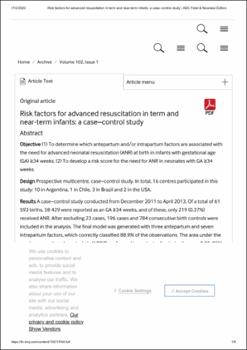| dc.description.abstract | OBJECTIVE:
(1) To determine which antepartum and/or intrapartum factors are associated with the need for advanced neonatal resuscitation (ANR) at birth in infants with gestational age (GA) ≥34 weeks. (2) To develop a risk score for the need for ANR in neonates with GA ≥34 weeks.
DESIGN:
Prospective multicentre, case-control study. In total, 16 centres participated in this study: 10 in Argentina, 1 in Chile, 3 in Brazil and 2 in the USA.
RESULTS:
A case-control study conducted from December 2011 to April 2013. Of a total of 61 593 births, 58 429 were reported as an GA ≥34 weeks, and of these, only 219 (0.37%) received ANR. After excluding 23 cases, 196 cases and 784 consecutive birth controls were included in the analysis. The final model was generated with three antepartum and seven intrapartum factors, which correctly classified 88.9% of the observations. The area under the receiver operating characteristic (AROC) performed to evaluate discrimination was 0.88, 95% CI 0.62 to 0.91. The AROC performed for external validity testing of the model in the validation sample was 0.87 with 95% CI 0.58 to 0.92.
CONCLUSIONS:
We identified 10 risk factors significantly associated with the need for ANR in newborns ≥34 weeks. We developed a validated risk score that allows the identification of newborns at higher risk of need for ANR. Using this tool, the presence of specialised personnel in the delivery room may be designated more appropriately. | en_US |


